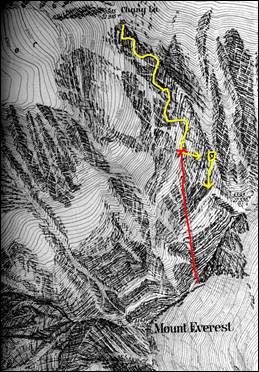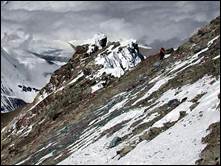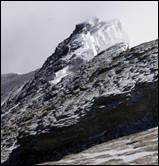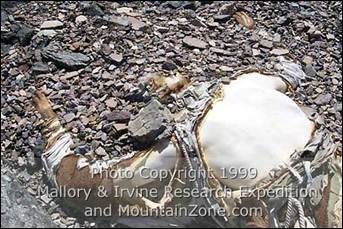
Left: George Mallory and Andrew Irvine © RGS/The Sandy Irvine Trust, from "Ghosts of Everest" ; Right: 1924 North Face locations © Pete Poston
| Photoanalysis | Routes & Maps | Video & Books | Contact Me |
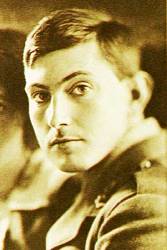
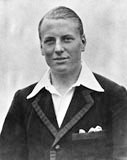
"I'm quite doubtful if I shall be fit enough. But again I wonder if the monsoon will give us a chance. I don't want to get caught, but our three-day scheme from the Chang La will give the monsoon a good chance. We shall be going up again the day after tomorrow. Six days to the top from this camp!"
--from George Mallory's last letter to his wife prior to disappearing on Mt. Everest with his partner Andrew "Sandy" Irvine in 1924
"My face is in perfect agony. Have prepared two oxygen apparatus for our start tomorrow morning".
- Sandy Irvine's last diary entry

Death came suddenly in the blink of an eye - Mallory and Irvine's Last Climb
© Pete Poston, April 20, 2013
Part 1 - The Ascent | Part 2 – The Descent
The summit pyramid loomed over them, foreshortened enough to make the decision to retreat even more agonizing. The oxygen is out, the hour was getting late, and the monsoon clouds were boiling and frothing below. Even Mallory, with his tremendous drive and determination to be the first to reach the top, had to admit that descent was the smart thing to do, especially given the earlier experiences with the atrocious weather that had decimated the expedition, resulting in two unfortunate porter deaths. Failure had reared its ugly head even before the expedition had really begun.
It’s now about 12:10pm; Norton had retreated from the Great Couloir at about 1pm and made it back to the North Col safely, Mallory was confident they wouldn’t have any difficulties, as well, even without oxygen. After all, the “rotter’s” gas was only beneficial on the ascent as everyone knew, so running out was not a problem.
“What a view!” Mallory croaks to his companion. “What a magnificent place to be!”
Irvine takes a few more photographs, including one picture of the aloof summit high above with Mallory forlornly gazing up at it, oxygen apparatus with only one bottle, mask and bladder dangling free in front of him.
Why do men climb? Mallory’s own words creep back into his mind – have we vanquished an enemy? None but ourselves, even more so when failing to reach the summit, Mallory thought. There are other enemies facing the mountaineer; the bitterness of defeat, the loss of pride, the realization that a career as a climber and journalist was probably over. He had promised Ruth this would be the last expedition. They would settle in to a more sedate life of raising the children and building on a teaching career. It was about time… for Ruth, at least.
One more defeat, in a way – never to return to his three year obsession to be the first to climb the mountain. The thought of others being the first was more than Mallory could endure. But with this defeat, the way would be easier for others to be victorious.
One last lingering glance at the summit peeking through the monsoon clouds; then a sudden movement of cold air sweeps over them, and they start to shiver in their inadequate clothing.
“It’s tough luck”, Irvine gasps, followed by a long fit of agonized coughing. Mallory merely nods, lost in his inner reflections of a new life ahead.
What to do with the oxygen gear? Their kit, including thermoses, was tied to the frame of the apparatus, so a tough decision was reached. Abandon the apparatus, or continue down without? Continue on without. Most of the rest of their belongings were hastily stuffed into pockets and bags, but the thermoses are regretfully left behind. No matter – most of the tea was gone anyway. They gulp down the remainder, and stuff the oxygen apparatus and thermoses into a convenient slot in the rock.
The traverse back to the head of the Subsidiary Couloir is uneventful – except for the now blustery conditions that remind them of the long, long way down they had to go. Longingly they gaze at the North Col barely visible through the mists, and dream of the cup after cup of tea they would be drinking, tired bones luxuriating in their soft down bags.
“Sandy”, Mallory pants, “We aren’t going to make it back to the North Col in these conditions. We can make it as far as Camp 6 before having to settle down for the night.”
Irvine replies, “At least the oxygen bottles and parts of the oxygen apparatus we left in the tent will help recover our strength and allow us to sleep a little better, perhaps. It worked last time, it should work again”.
They gingerly descend the steep and slippery Subsidiary Couloir, the harder patches of snow easy on the ascent, slippery on the descent. Mallory uses a psychological belay for Irvine as he carefully climbs down from step to step, carved out of the ice and snow on the way up. When it’s Mallory’s turn to follow, both of their lives depend on his incredible skill and grace to descend without slipping and pulling both of them to a screaming death down the endless ice fields of the Great Couloir, to a fate only guessed at as they tumbled and bounced their way to oblivion.
The crossing of the Great Couloir was, by comparison, much easier, mainly due to the steps and lower gradient. Both men exhale their breath which had been nervously held as they finish crossing the tricky slabs and ice fields. It’s now about 12:50 PM.
Suddenly the curtain of clouds swirls away in a magnificent display of theatrics – the entire upper portion of the mountain is revealed, and they can easily see the route ahead as far as the 1st Step. Cheered by the sunshine, with a jolt of new energy in their tired legs, but still gulping air like a fish out of water. They eagerly continue on, reassured that the worst of their climb was over.
But it wasn’t meant to be. About five minutes later the clouds close in tighter than before, swirling around them and teasing them with caressing, ghostly fingers of ice and cold.
The gorak passes them again with a croak and a barely heard flapping of wings.
![]()
A thousand feet below, Noel Odell is taking a circuitous route onto the North Face as he climbs up to Camp 6. A geologist by profession, but one hell of a mountaineer, too (he and Bill Tilman were the first to climb Nanda Devi), Odell is looking for traces of fossils on Mount Everest. He had just found some – the first ever to be found on Everest – or so he thought (it turned out later they were not, but there are fossils on Everest, including on the very summit) – when he decided to climb a little crag just to test his fitness. It was here, at the top of the crag, that he saw the clouds part on the upper slopes of Everest, and the entire summit ridge was unveiled, including the 1st and 2nd Steps. Odell’s attention was drawn to the 2nd Step, where he maintained throughout his life that he saw moving figures, climbers on the 2nd Step that could only have been Mallory and Irvine, climbing the Step “with alacrity”. |
|
After 5 minutes the clouds closed in again, and Odell never saw the upper part of Everest again until late in the afternoon. By then there were no signs of the climbers.
But did Odell really see climbers? Could anybody really climb the 2nd Step in only 5 minutes? Or was he deceived by the altitude and the tricks your mind can play on you?
People would argue about it for decades, and the debate continues to this day. In 1933, when the 1933 expedition film was shown at a meeting of the Royal Geographical Society, during the discussion afterwards doubts were raised whether or not Odell saw anything at all, to which Odell responded in the Alpine Journal:
“…I myself was unable to attend the above meeting; but I have been told that during the discussion doubts were again expressed in certain quarters as to whether I had actually seen, or could have seen, as I claimed, the figures of Mallory and Irvine on the NE Ridge of the mountain at the First or the Second Step.”
“Now, this doubt had been forcibly expressed by Hugh Ruttledge in his review of The Story of Everest, by W. H. Murray, in A.J. 59 220, when he declared ‘I think that such evidence as we have indicates inexorably that Odell was mistaken in supposing that he saw them at all!’ To this I then replied (in AJ 59 495-6); ‘I can assure him (Ruttledge) that if ever I was certain of any observation, scientific or otherwise, which I have made upon a mountain, I can claim definitively to have seen Mallory and Irvine, as I reported, on that fateful day on June 1924’. I still maintain this attitude. N. E. Odell”
![]()
The way ahead is now almost obscured. Norton had told Mallory of he and Somervell’s easier line of descent, and Mallory had wanted to take it down, and so he keeps an eye out for it as they traverse the slabs leading back to the 1st Step.
Another violent gust of wind; the clouds start to well up from below again, twisting and spiraling around them as the Great Western Disturbance and jet stream finally reaches the mountain. In the rapidly decaying conditions, locating Norton’s easier descent route is hopeless, so Mallory makes the decision to continue along their ascent route. Although higher in altitude at a time when descent to lower elevations is the wisest course of action, Mallory thinks to himself that it’s the most prudent decision; better the known to the unknown.
At about 2 PM they reach the slabs below the First Step, and it’s here that the Dogs of Chomolungma are released from their cages – a storm blows across the Face from the West with a ferocity and fury never experienced before by any climber of Everest before, and it’s here that the fate of Mallory and Irvine is sealed.
Feeling the advancing gusts, Irvine squints behind him and is greeted with a vision of Hell that would put Dante to shame. Frank Smythe wrote about his own experience with the same kind of horrible weather in 1933:
“… I saw a curious fuzziness in the north-west. Quickly it concealed the final pyramid and advanced along the slabs. Scarcely before I had to realize what it meant, a gust of wind nearly blew me from my holds. Then came another gust and another, and before I had time to move a hurricane was raging.”
“….All the malignity and intolerance of Everest were concentrated in that withering blast. And the cold was proportional to the wind, the most paralyzing cold I have ever known. It was not content merely to numb my hands and feet; it seized my whole body in a merciless grip.”
Such is the storm that engulfed Mallory and Irvine. An Into-Thin-Air kind of storm that, seventy-two years later, would claim the lives of nine climbers on the south side of Everest in 1996. There’s no defense to the jet stream as it lashes the heights of Mount Everest, no place to hide.
Mallory and Irvine’s clothing was only adequate for good weather conditions, amazingly adequate given the experiences of modern climbers under similar conditions with all the technological advances of down-filled, synthetic clothing. But hopelessly inadequate now.
“George, My fingers and toes are starting to lose sensation”, Irvine exclaims. Mallory’s extremities aren’t doing much better, but he maintains a stoic pose so as to not alarm his inexperienced companion. Mallory knew they were quickly freezing to death, and the descent was a race to make it to the shelter of Camp 6 before they inevitably lay down and succumbed to the paralyzing cold and exposure.
Damn, Mallory thinks to himself. I sure could use that compass I left behind in Camp 5. What a bloody stupid thing to do.
Mallory’s goggles start freezing up; the same thing is happening to Irvine who is gamely following along in his footsteps. Under these conditions it’s hard to decide whether to keep the goggles on or to take them off. With the screaming wind behind them, it’s easier to take them off without being blinded so badly that seriously compromised vision is better than no vision at all.
Mallory stashes his goggles in a pocket and fights his way across the now icy, tilting slabs comprising the North Face of Everest. Every step requires the utmost concentration to avoid a slip, even though the terrain is relatively easy, Mallory could feel the hairs on the back of his neck itching and tingling as his climber’s intuition warned him of the rapidly increasing danger of their situation.
Out of the mist and blinding snow a flat slab appears before him, easily bypassed on the way up, trickier on the way down. Mallory passes the slab on the left, leaning on it with his ax as he takes a quick breather before continuing on. |
|
|
Irvine is carefully following Mallory’s every step, and when he reaches the tilting slab, he too leans against it with his axe and starts to take a breather. Mallory is about 100 feet ahead of Irvine (the standard length of a climbing rope in 1924), and maybe 50 feet lower in elevation, feeling his way through the abominable conditions. Scared, very scared.
Suddenly, without warning, Irvine is wrenched from his stance. His ax screeches downwards across the slab seeking purchase, and he slams heavily against the elevated edge of the slab, knocking the breath out of him; stars dance before his eyes as his head smacks the edge of the cruel slab. The slip causes him to lose his grasp of the ax, which remains behind, lying freely on the slabs for many years to come.
The violent tug of the rope has caused Irvine to slip downwards about twenty feet before he is able to claw against the rocks and bring himself to a merciful stop. Stunned by the quickness and force of the fall, Irvine slowly comes back to his senses. Glancing about him, he sees the axe on the slab above, when suddenly he is violently jerked forward again by the thin little rope binding him to Mallory. Mallory has fallen and pulled Irvine off of his feet at the worst possible moment.
Mallory had been cautiously clawing his way downwards, his total concentration on the next few steps ahead of him. He is in midstride down a short cliff when a violent gust of wind knocks him off of his tenuous holds. Completely out of control, with tricouni nails wildly screeching on the smooth limestone rocks, Mallory plummets over the cliff. When the rope pulls taught against Irvine, who is still recovering from the fall, the inadequate rope breaks over an edge of rock, and Mallory plummets from view, leaving Irvine even more injured and even further below the slab holding his ice ax.
When discovered 75 years later, blood stains are found on the front of Mallory’s gabardine jacket, and wipe marks are found on his sleeve. Most of the blood comes from scrapes and scratches caused by his impact with the limestone, but in addition, the glass on the altimeter was shattered by the fall, causing deep bloody cuts. In shock and pain, he wipes his wounds as well as he can, and picks the remaining shards of glass out of the little bag he always wears around his neck for a quick retrieval of important items of equipment frequently used while climbing.
When recovered in 1999, the hands of Mallory’s altimeter were missing, but two rust marks were left behind on the face. One of the rust marks points to 25,650 feet, while the other one is at 27,850 feet.
The ice ax was found in 1933 on its slab at 27,760 feet, which coincidentally is almost 100’ lower than the mark on the altimeter face at 27,850, which is the same discrepancy in altitude Mallory thought Camp 6 was at when he set the altitude that morning. This rust mark is mute testimony to the drama that unfolded at the ice ax site in their desperate struggle to survive.
In the freezing cold, after a short time Mallory’s wounds mercifully stop bleeding. It’s the last bit of mercy Chomolungma shows him in the last hour of his life.
It’s now about 2:20pm. The storm continues to rage about them, the cruel wind finding its way into every nook and cranny of their clothing, freezing fingers of death penetrating further and further into flesh and sinew, slowly freezing their oxygen-starved bodies.
Both climbers are faced with a life and death decision, to search for his companion in the killer storm, or to find their way back to Camp 6 alone. Neither climber can see the other, even though the distance between them isn’t very far. But they might as well have been a thousand feet apart, because Irvine didn’t know if Mallory had slid all the way down to the bottom of the mountain to his death, and Mallory didn’t know if the same had happened to Irvine.
“Halloooo”, Irvine shouts into the nothingness. His shouts were quickly blown away in the gale, so communication was hopeless. Their steps in the snow were blown away within seconds, so there was no way for Irvine to follow in Mallory’s footsteps. It was every man for himself.
After watching his companion disappear without a trace into the void, and now light-headed and dizzy from the fall, Irvine wraps the remainder of the rope around his shoulder and continues along the ridge, confused and partially unaware of exactly where he is. He knows that on the way up they had popped out onto the ridge somewhere, but doesn’t realize he has already passed the route back down.
Mallory is in terrible condition, too. He decides to descend vertically down the Face, hopeful that he can reach better conditions the lower he got. He still hasn’t forgotten Norton’s words to him about his ascent route with Somervell, lower down the steep slopes.
Heartbreakingly close to making it to the scree slopes below the Yellow Band, Mallory gropes his way downwards, but at the very bottom of the Yellow Band, comes up short against a cliff band with no visible easy way down it. Desperately he searches for a way down when he finds a steep little gully that appears to penetrate the little cliff band and emerge onto the safer terrain below.
Andy Politz will investigate this gully in 1999 since it lies directly above Mallory’s fall line, but no traces will be found.
He teeters down the little gully, and inevitably he finally slips; gravity greedily sucks at him and quick as lightening he is plummeting down the little gully. There’s not enough time and distance for the ax to bite into the snow and self-arrest. His leg smashes into the side of the gully, and his old injury to his weakened right ankle results in instant smashing and breaking of the bone. Mallory tumbles down the slabs at the bottom of the Yellow Band, hits the scree and snow slopes below, and then starts tumbling and bouncing, losing his axe, and dislocating his right shoulder in an agonizing spasm of pain.
Instinctively, Mallory is able to flip over onto his stomach, and desperately claws at the icy slopes. His gloves rip off, his boots bite into the scree, his broken ankle bounces off the scree again and again; his mind is filled only with terror and red-hot, searing pain.
It’s over. Death comes suddenly to Mallory in the blink of an eye. Lying flat on his stomach and clawing at the snow and rock above, he slides over a little outcrop of cruelly sharp, metamorphosed rock. The sharp edge of rock punctures the left side of his forehead, killing him instantly. A flood of stones displaced by his fall continues to sail by him, slowly decreasing in magnitude until the only sound is from the wind and the wildly swirling snow. It’s 3:40pm. But what of Irvine? |
|
![]()
Xu Jing is the Deputy Leader of the Chinese 1960 expedition that was the first to climb the Northeast Ridge up the 1st and 2nd Steps to the summit. Attempting the summit with three other companions, he is on his last dregs of energy. Despite several attempts to follow, he finds himself unable to keep up with his companions on their summit assault, and reluctantly – but inwardly relieved – he turns around and heads back to the Chinese Camp 7 located on the ridge below the 1st Step. Exhaustion dogs his every step. Upon reaching the camp, a little food raises his energy enough that he decides to climb all the way back down to Camp 6, some 1000 feet below. He’s so tired that he doesn’t even take his expensive Leica camera.
What Xu Jing finds will rewrite history.
The Chinese route in 1960 - and later in 1975 – varies from 1924 in that they abandon the spiny North Ridge and climb out onto the vast slabs of the North Face instead, up a little ill-defined, rounded ridge of boulders and scree, eventually reuniting with Mallory’s route at the base of the Climber’s Gully penetrating the Yellow Band and ascending to the Northeast Ridge above.
The steep route down the Yellow Band is dangerous for an exhausted climber to descend, and in 1960 the Chinese did not use fixed ropes. Xu Jing decides to take an easier, more direct route down, instead of angling down the endless steep, smooth, treacherous slabs of yellow limestone below.
Little does he know that he is following in the footsteps of a lonely, lost and exhausted climber from 1924, who has also decided to take an easier way down.
![]()
Andrew Irvine is terrified; for all he knows his friend and mentor George Mallory has plunged all the way to the bottom of the mountain to his death. Repeated shouts are blown away by the wind; his breath is sucked out of him every time he opens his mouth by the force of the screaming wind.
The Northeast Ridge of Mount Everest is not a good place to be in a storm with the cornices overhanging the Kangshung Face inviting an unwary climber to step a little too far out, only to break through and fall to the glacier impossibly far below. Think of Herman Buhl on Chogolisa. Irvine traverses a safe distance below along the boundary between rock and snow.
Irvine misses the way down the Yellow Band taken on the way up, and soon finds himself confronted by two large towers barring the ridge. He is forced to his left and downwards, entering a region of frozen boulders, scree, and short little gullies.
Irvine is at the end of his tether; no one can stand up against this brutal storm at over 8400 meters on Mount Everest for any extended period of time, especially after climbing so high and running out of oxygen. Reduced to crawling on his hands and knees, Irvine wriggles headfirst down into a little gully, about a meter wide with steep cliffs on either side. He lies down and slowly, slowly the clock of his life silently ticks down. At about 3:30 in the afternoon, Andrew Irvine expels his last breath and soundlessly freezes to death.
![]()
Xu Jing reaches the two towers blocking the ridge, and realizes that at some point he needs to start angling down. This is as good a place as any. He too, threads his way through the scattered boulders and ledges until he finds a little gully that promises an easy way down. He starts climbing down, his thoughts only of the comfort of a warm sleeping bag at Camp 6, and a hot cup of tea.
Suddenly he comes across a patch of green, completely different from the earthen colors of yellow, sienna and gray that characterized the rest of the Face. Slowly his tired mind begins to recognize the figure of a body lying in the gully, blackened face and gaping teeth grinning horribly up at him, feet pointing upwards toward the summit of dreams above.
It’s a beautiful place to lie down for eternity, the finest cenotaph in the world.
![]()
Noel Odell cowers behind a boulder further down the North Face of Everest, sheltering from the violent gusts and sheets of driving sleet and snow. He’s lucky, the severity of the storm is much less at his lower altitude; the jet stream that had descended onto the upper slopes of Everest hadn’t penetrated as far as he was, sparing him the brunt of the madness raging around Mallory and Irvine above.
A similar phenomenon had occurred to Frank Smythe when caught out by the storm in 1933. He relates:
“Providentially the wind lessened considerably as I lost height. At about 26,000 feet it was blowing an ordinary gale and visibility had improved to such an extent that there was risk of missing Camp 5 as I had feared at one time.”
During a lull in the storm Odell ventures out, now very concerned for his companions who must have been very far along the ridge before the storm blew in. He shouts, whistles and yodels in a vain attempt to guide the two climbers back to safety.
After climbing up to, in his own words, “about 28,000 feet or so”, he turns back since the hour was getting late, and he knew that he must get down to the North Col and not take up space in the tiny tent at Camp 6 where there was no room for three climbers.
When he reaches the camp at about 4 PM, the storm suddenly ends. Peering upwards, Odell strains to see any traces of the climbers on the ridgeline above, but all he sees is freshly-fallen snow. Descending rapidly, he reaches the safety of the North Col at about 7 o’clock. He sees no signs of his friends through the long night.
The next day brings no sign of the climbers. A decision is made.
![]()
Far, far below, the soaring gorak sees a tiny figure climbing up to the little tent tenuously grasping the stony ridge below. The little figure reaches the tent, but doesn’t stay long; instead the tiny figure immediately starts laboriously climbing up the frigid scree slopes above. The gorak is amused, it can fly wherever it chooses in a fraction of the time it takes this little creature to move.
The gorak is soon joined by his companions, and they start wheeling around the lonely climber below. The wind is blustery, and the goraks’ wings rock back and forth in the sudden gusts and updrafts. No worry, they’re used to it.
The dark cerulean sky is so clear that stars come out in the middle of the day. Once again Chomolungma smiles down on the earth below.
After several hours the lonely figure stops and glances at the inaccessible summit above. The goraks fly in closer, curious to see what the strange creature is going to do next. After a brief pause, the figure heads back the way it had ascended. The goraks can sense in the slumped shoulders and frequent backward glances the sadness the little figure is feeling; it’s not hard to imagine.
But the goraks remain behind. It will be a long time before they see these strange little creatures at these heights again.
And besides, something has attracted their attention below.
Epilogue
It was a difficult decision to rule out Odell’s sighting as real. After all, he was a trained scientist, with powerful observational skills, and a keen vision that never left him throughout his long life.
But leaving Odell’s vision out of the equation simplifies so much in the Mallory and Irvine story. You don’t have them climbing an obstacle that we know was beyond Mallory’s rock climbing experience, we don’t have to drag a complete novice along, and we don’t have to worry about how on earth they would have been able to descend the 2nd Step on their way back.
It has always bothered me, and continues to bother me, that anyone would launch up the notoriously difficult 2nd Step and climb it in only 5 minutes without at least taking a breather and reconnoitering the way ahead.
And we also don’t have to have them climbing at a fantastic rate to reach the 3rd Step by 12:50 pm, or climbing the 1st Step at such a late hour. It makes theorizing so much simpler.
I was also tempted to leave out Xu Jing’s story as well, but only one thing stopped me, and that was the report that a foreign climber was found on Everest wearing “braces” that was revealed at the 1965 meeting of the St. Petersburg Alpine Club:
“At an altitude of about 8600 meters we found the corpse of a European... He was wearing braces.”
“Braces” is another term for suspenders, something Irvine is known to have worn.
This is corroborating evidence that simply can’t be ignored. In addition, Chhring Dorje’s encounter with an old body can’t be ignored either, since he has Sandy “guarding the Kangshung Face” as revealed by EverestNews.com to an inquiry by a student of the disaster.
Will Andrew Irvine’s remains ever be found? It seems less and less likely as time goes on. Jochen Hemmleb’s two searches near the Twin Towers yielded nothing after scouring the area in 2010 and 2011. It’s possible however, that Tom Holzel has located the body using photoanalysis of high resolution photographs of the North Face, but in a different place. Only boots on the ground will verify that theory once and for all. And Mount Everest is a big, big place, with a protective covering of snow and ice that makes any search problematic. A searcher could easily pass right by Irvine’s body without even seeing it, such is the vastness of the sea of slabs that makes up the North Face of Mount Everest.
After so many fruitless searches, some students of the mystery of Mallory and Irvine’s fate are moving on to other things, content to let a mystery remain a mystery.
Perhaps it’s better that way; Sandy Irvine’s remains will remain undisturbed, and he will rest in peace in one of the most beautiful places imaginable.
Pete Poston
Philomath, OR
USA
Part 1 - The Ascent | Part 2 – The Descent
Acknowledgements
Thanks to Eric Simonson for discussions about his climb with Ed Viesturs in 1987, multiple-summiteer Jamie McGuiness for his deep knowledge of the North Face of Everest, Richard McQuet for his insights into Irvine’s mofified oxygen apparatuds, and as usual, thanks to Tom Holzel for his helpful editorial suggestions.
Suggested Reading
- "Last Climb: The Legendary Everest Expeditions of George Mallory", David Breashears and Audrey Saulkeld
- "The Fight for Everest 1924", E.F. Norton
- "Ghosts of Everest: The Search for Mallory & Irvine", Jochen Hemmleb, Larry A. Johnson, Eric R. Simonson, William E. Nothdurft
- "The Lost Explorer: Finding Mallory On Mount Everest", Conrad Anker and David Roberts
- "The Story Of Everest", John B. L. Noel
- "Through Tibet to Everest", J.B.L. Noel
- "The Mystery of Mallory & Irvine", Tom Holzel and Audrey Salkeld
- "The Story of Everest", W.H. Murray
- "Everest: Eighty Years of Triumph and Tragedy", Peter Gillman, Leni Gillman, Audrey Salkeld

Articles and Editorials
![]() Harvey V. Lankford, MD, has written a paper documenting the origin of the term "Glacier Lassitude" as a diagnosis for the debilitating effect of altitude as experienced by members of the early British Everest expeditions.
Harvey V. Lankford, MD, has written a paper documenting the origin of the term "Glacier Lassitude" as a diagnosis for the debilitating effect of altitude as experienced by members of the early British Everest expeditions.
![]() My new theory about Mallory and Irvine's last climb, where I believe Odell's sighting was erroneous, and have them taking the Couloir route instead.
My new theory about Mallory and Irvine's last climb, where I believe Odell's sighting was erroneous, and have them taking the Couloir route instead.
Part 1: the ascent
Part 2: the descent
![]() Warwick Pryce is a new researcher who has arrived on the scene, and he has a new theory about how Andrew Irvine could have been the first person to stand on the top of the world.
Warwick Pryce is a new researcher who has arrived on the scene, and he has a new theory about how Andrew Irvine could have been the first person to stand on the top of the world.
Wim Kohsiek has a new interpretation of what Mallory's altimeter can tell us based on scientific applications of meterology.
Mallory and Irvine researcher Wim Kohsiek has two new thought-provoking articles about Mallory's watch and Irvine's location:
Mallory's Watch - Does it Really Point to 12:50 PM?
1924 Oxygen by Richard McQuet and Pete Poston
Why the Camera and Film are not Doomed to Destruction!
The Politics of Mallory and Irvine
Why Andrew Irvine Will Not be Found in a Sleeping Bag! Part 1 and Part 2 on ExplorersWeb
Chomolungma Nirvana: The Routes of Mount Everest
Rust Marks on Mallory's Altimeter
Mystery of Mallory and Irvine's Fate Google Earth Tour - my own ideas in 3-D with audio!
Little Known Free-Solo Ascent of the Second Step in 2001 by Theo Fritsche - I should never have written this - Anker and Houlding deserve credit for the first free ascent
Criticisms of the 2004 EverestNews.com search for Irvine --
The Mystery of Mallory and Irvine's Fate (with J. Hemmleb): Part 1, Part 2, Part 3, Part 4, Part 5.
Mallory and Irvine - Comments on the 'real Second Step' route: Part 1 and Part 2
Conrad Anker's comments on the unlikeliness of a direct route up the prow of the 2nd Step
Articles about my heroes Walter Bonatti and Chris Bonington --
Spilling the Beans - Lino Lacedelli's Book "Price of Conquest: Confessions from the First Ascent of K2" Part 1 and Part 2
The Life and Climbs of Chris Bonington, Part 1, Part 2, Part 3, Part 4, Part 5 final - interview
About Me
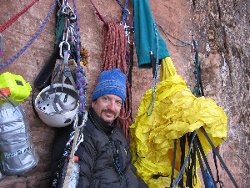 Celebrating my 50th birthday on pitch 3 of Prodigal Son, Zion National Park, Utah
Celebrating my 50th birthday on pitch 3 of Prodigal Son, Zion National Park, Utah
In my free time, I love to photograph and hike the spectacular redrock wilderness of the Colorado Plateau - please visit my Colorado Plateau Homepage.
And for most of my life I've been fascinated with the history, people, and culture of the Himalayas and Karakoram - browse my Mount Everest Trek (1996), Overland Journey from Kathmandu to Lhasa (2000), and K2 Base Camp Trek (2007) webpages.
As for my employment, I work for Western Oregon University where I have been a Professor of Chemistry for the last 20 years. My research interests are in applications of Laser Raman Spectroscopy to such diverse fields as Nanotechnology, Analytical Chemistry, and even a bit of Achaeology through the study of rock art pigments found in the Colorado Plateau. You can access my academic webpage here.

Copyright (c) 2004-2022 Pete Poston. All rights reserved. Visitor's Agreement |
